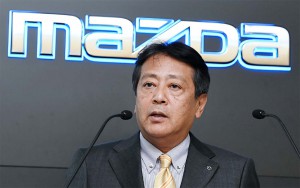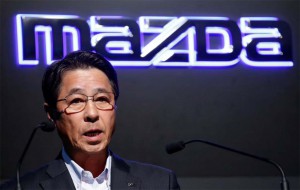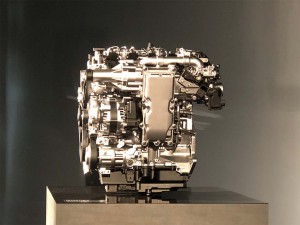Mazda Motor Corp.’s president and CEO will step down next month and will be replaced by the executive currently overseeing its biggest market, the Americas, and North America, in particular.
The transition, which will see current Vice President Akira Marumoto take the helm, comes at a critical time for Japan’s fifth-largest automaker. After having its long-time partner, Ford Motor Co., sever ties, Mazda has been searching for new allies and over the last 12 months has announced several projects with industry giant Toyota that will see it share in a new, U.S. assembly plant. Mazda is also pushing to develop costly new powertrain technologies at a time when most markets are demanding significant improvements in fuel economy and emissions.
“Given the rapid changes occurring in the auto industry at the moment it’s often asked whether a small company like us will be OK,” the 60-year-old Marumoto told reporters in Japan on Friday, cautioning that, “before we even consider this we need to show our strengths, and what makes us different if we want to grow our brand.”
(Click Here for a first drive of the 2018 Mazda3 Grand Touring.)Outgoing President and CEO Masamichi Kogai helped put in place many of the changes that Mazda hopes will be seen as signs of strength.
Among other things, that included last year’s announcement that Mazda would enter into a joint venture with Toyota Motor Corp., the biggest of the Japanese carmakers and third-largest worldwide. Together, they will invest $1.6 billion to build a new assembly plant in Alabama that will open early in the coming decade.
It marks the second alliance Mazda has negotiated since ending a long partnership with Ford Motor Co. that was abandoned during the Great Recession by former Ford CEO Alan Mulally. Mazda teamed up with Fiat Chrysler Automobiles on the development of a new roadster updating its popular Miata nameplate. FCA is selling its version as the Fiat 124 Spider.
The deal with Toyota is clearly the more far-reaching. For one thing, it will give Mazda its first manufacturing base in the U.S. since it abandoned the factory it jointly operated with Ford in the Detroit suburb of Flat Rock, Michigan.
(Click Here for more about Mazda and Toyota’s new shared plant in Alabama.)
It also will see the two carmakers jointly develop a new line of battery-electric vehicles – a first for Mazda – which will be assembled at the new plant. While the Trump Administration is expected to roll back the current, 54.5 mpg target for the U.S. Corporate Average Fuel Economy standards, industry analysts believe battery-based technology will be critical for manufacturers to add to their portfolios in the coming years. And Mazda will be able to use those vehicles to meet increasingly stringent emissions and mileage standards in Europe, China and other markets.
Under Kogai, the carmaker also reached a critical point in the development of a technology that has befuddled automotive engineers for decades. Generally known as homogenous –charge compression ignition, or HCCI, it aims to combine the benefits of diesel and gasoline engines. Mazda is preparing to launch its version as the new SkyActiv-X and claims it will yield near-hybrid fuel economy without the cost of electrification.
(Mazda’s SkyActiv-X aims to give diesels, hybrids a fuel-efficient run for their money. Click Here for the story.)
The outgoing CEO will become the third Mazda chief in a row to step down after five years. Kogai will retain a role with the company, however, as its new chairman.
As for Marumoto, he is a 38-year Mazda veteran who admits to having a “strict” work ethic and, according to a Reuter’s report, a “short temper.” In keeping with the small automaker’s focus on product, he is an engineer by background, though he has also worked in corporate planning and product strategy.
His current job job as vice president and board member for MMC has him overseeing Mazda’s largest regional unit. In 2017, Mazda North American Operations reported sales of 289,470 vehicles. That was down 2.8% compared to 2016, but a slightly smaller decline than the overall North American market experienced. Behind the numbers, the region’s Los Angeles-based CEO Masahiro Moto intentionally started pulling Mazda out of the low-profit rental market, fleet sales dipping 44.3% for 2017, while more profitable retail volume bucked the industry trend and rose a modest 0.2 percent.
The incoming president and CEO says he hopes to burnish Mazda’s image for innovation with technology like the SkyActiv-X engine. He also wants to boost profitability in North American and grow sales globally.



